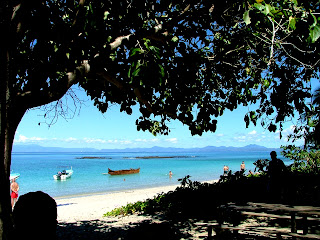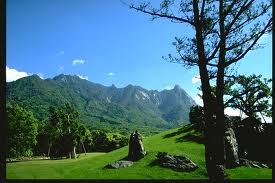Today we woke up to crystal clear blue skies and not a cloud in sight. Tankers are clearly visible as they skirt the horizon on their way into or out of Valencia harbour over 50kms away. The mountain tops all round bake in the rising heat, the only sound the gentle hum of cicadas rising to a pitch and falling away again like so much traffic passing me by. It's a beautiful day here in Valenciana and as I sit and punch the keys in front of the window it feels like a place apart. It's so quiet up here away from the hustle and bustle that it can be hard sometimes to find a connection with the rest of the planet. It's as if what happens elsewhere is unrelated in every possible way. My world begins and ends with the vista at my fingertips. Life is just a animated image that slips by outside my window, the cicada engines marking the passing of time as they rev and stall, rev and stall.
Figure 1. The sun comes up as another beautiful day looms.
But I do not live in a glass cage. Later in the day, when the glare of the early morning sun has faded, life comes back to bite you as the fire ravaged peaks can then be seen for what they are; ghostly reminders of the consequences of how we live. It hasn't rained here for almost 17 months now. Most predictors of global warming show the largest part of Spain turning to desert within the next 50 years as rainfall patterns get turned on their heads and global temperatures rise. Fires, like the one we have just recently experienced here, are surely set to become a regular part of life in rural Spain.
The local Valenciano government have announced the first part of a 'rescue' package to help the people in the affected areas around Andilla. In September 9m Euros will be made available to help those who lost their livelihoods in the disaster. This money is also to help with the replanting of the forests, to provide some work for locals and to aid the regeneration of the scorched mountains and valleys. It is a positive first step and the action has been taken remarkably quickly for a people entrenched in the manana culture.
When thunder clouds finally do unleash their pent up fury upon this land those areas that have already been destroyed will suffer further denudification because there is now nothing left in the soil to prevent further degradation of the land. The ash and any richness left in the topsoil will simply be washed away.
When it does rain here, it does so in force. Forget cats and dogs, we're talking giraffes and elephants! And the land is packed so hard and dry that the first heavy rainfall will just bounce off the surface taking that life-giving topsoil with it as it rushes down the mountain sides and ridgetops, leaving the land behind more sterile and inhospitable than ever, and the lowlands probably flooded (mark my words). Gaining a foothold here afterwards would be an exercise in survivability for any organism, be it plant or animal. Darwin's survival of the fittest put to the toughest of tests.
However, these sort of problems are not limited to Spain. Environmental catastrophes are almost a daily occurrence. Most just pass us by with nothing more than after thought. An oil spill here, a flood there, a forest fire elsewhere - the list is endless and growing longer each day. It's not until you're faced with such a catastrophe that you really sit and take notice.
But conservationists and climatologists have been telling us for decades that the earth will pay the price for our many environmental extravagances. But it is money that makes the world goes round and conservation. It is economics that dictates which extravagances are worthwhile and which are not. And conservation has to pay its' way just like anything else. For most the chance to make a buck or two outweighs any environmental considerations. What's more that statement rings true at every economic level; the individual, the company, the government. The dangers and the perils of stripping our planet bare are well known and yet it goes on all the same because of the need to satisfy our economic desires and materialistic ambitions. I'm not immune to this and I've no doubt, nor are you.
I applaud the readiness of the Valenciano government but I can't help asking if it's not a little too late. Are we not just pissing in the wind? Once again throwing money at a problem in the hope it will go away?
The problems are many and the solutions few. The vanity of man leads us to believe that we know more or know better than nature itself, forgetting of course, that we are just another ongoing evolutionary accident of nature rather than its' pinnacle. Thus we continue to interfere, to poke and to probe, to give nature a little nudge in the right direction........
9m Euros is a start but I wonder if anything will change with this money or will things just be put back how they were before? My neighbour tells me that when he was a kid growing up here the mountains were completely forested, big pines dominant as they should be all along the Mediterranean coastlines. Now the forests have been largely felled to fill our living rooms with fashionable furniture, to warm our feet on cold winter nights and to make way for plantations of quicker growing pines that can be harvested more often and can increase profits. Our ambition, it seems, knows no end. Our myopia, simply incurable.
Deforestation causes environmental problems wherever it occurs, however it occurs. I myself have seen the consequences on many occasions, in many places. In Madagascar - no doubt one of the most beautiful places on earth at one point - the effects have been particularly badly felt (Figs 2 & 3). One of the poorest countries in the world (see CIA World Factbook), Madagascars problems are almost inevitably compounded by a less stable political arena and blood-sucking logging companies who would strip what remains of the forests given half a chance. With little natural resources left the immediate future is not looking good for Madagascar. A coup in 2009 caused tourism to drop by 50% and if what little remains of the forests is lost then that figure would drop to zero. But how do you tell a guy not to chop that tree down because it's bad for the environment when his family are starving and they have no gas to cook with?
I put it to you that it would be extremely difficult.........
Figure 2. I travelled from the capital Antananarivo north to Mahajanga and then again to Diego and finally Nosy Be. More or less the whole island was at one point forested. Now, following soil erosion caused by the hacking down of the precious trees, hour after hour passes in a car in abject monotony. Nothing can grow in these areas. The soil has been completely stripped of any nutrients, to the extent that a tree becomes a highlight on what, not so long ago, would have been a journey through paradise.
Figure 3. As far as one can see...nothing but bald, sterile mountain ranges.
Figure 4. In the middle of the Indian Ocean and with a largely tropical climate Madagascar was once a lush, green paradise.
Figure 5. Around Nosy Be it was almost too beautiful for words.
But these problems are by no means limited to the poorer nations. In Japan and China problems arising from the removal of natural forest, particularly the slow-growing hardwoods typical of rain-forests around the globe, and the subsequent re-planting oif these areas with trees that are more 'profitable' has led to huge problems with landslides.
I was lucky enough to complete part of my post-graduate studies on the beautiful Japanese island of Yakushima in the Pacific. Covered in dense, warm-temperate rainforest Yakushima must be one of the most stunning places on the planet to visit (see Figs 6-8).
Figure 6. Dense warm-temperate rainforest blankets Yakushima.
Figure 7. A century ago the island was covered in huge, ancient Yaku-sugi's (Cryptomeria japonica) some of which may have been several thousand years old.
Figure 8. Above the treeline areas of ancient cloud forest and open alpine pastures provide a stark, yet beautiful contrast to the dense forest.
My studies were centred around the regeneration of the forests following heavy logging during the first half of the 20th Century. Many of these areas were replanted with much quicker growing pines and then these were in turn hacked down when of profitable age. The soils of rainforests are typically very poor and often very shallow, with the vast majority of the nutrients locked away in the plants, trees and animals that live there. Yakushima is no different. Once the natural forests were chopped down, the soil will support new growth (of re-planted trees) for only a few years before the soil becomes completely denuded. But unlike Madagascar, Yakushima is one of the wettest places on the planet (officially figures list between 4,000 and 10,000mm of rain per annum) and is precipitous in the extreme all over the island. When it rains (which it does 35 days a month according to locals) the plantations were simply unable to hold the surface together. The roots of the trees just did not hold the soils together in the same way as the plants that had evolved to live there (Yakushima has many plants and animals that are endemic to the island) - and the result? Huge landslides all over the island. Whole mountain sides literally slipping their moorings and taking a wander down the hill, courtesy of gravity and a whole load of water.
I saw it myself. One day a huge tropical storm passed close by with Yakushima still far from the eye of the storm. The following day I tried to go to work in the forest only to find as I drove along the one road on the island that the one road wasn't there any more! I turned a bend and where the day before there had been a mountain, there was now only a huge, ugly scar. Upon closer inspection I could see the road and the mountain had just slipped about 75m down the side and into the sea. There was the section of road below me...still intact!
The Japanese however, were quick to learn from their mistakes though. Logging was banned, the whole island protected and subsequently became Japan's first World Heritage Site. The plantations are now being left to die out on their own, leaving the rainforest to re-invade as the opportunity arises.
And by circuitous routes back to Spain....... where I do applaud the swift action of the local government, but only provided they take on board the lessons of the recent past. Re-plant? Sure! But use plants and trees that would form part of the climax vegetation* of the area. Re-plant it how it should be, not how you would like it to be! And for Heaven's sake please, please leave decent fire breaks, not tiny avenues wide enough for a lone cyclist that are covered in debris, dead branches and years of dried up pine needles! Spain has land a-plenty but dwindling areas of primary forest. Instead of plantations in the mountains why not encourage natural regeneration and restrict plantations to areas which have already been used for agriculture and are now deserted, of which there are many, everywhere you look.
Thanks for listening to my blab!
P XXX
* Climax vegetation is that which, given enough time, the land would naturally return to.








No comments:
Post a Comment